Chilingarian G.V. et al. Surface Operations in Petroleum Production, II
Подождите немного. Документ загружается.


455
Robinson,
J.M.,
1977.
Thermal DeNO, Demonstration Program. Steam Generator 42,
KVB 21100-751.
Sachtschale,
J.R.,
1980. Experience with dual alkali scrubber systems in oilfield operations.
In:
Pacific
Vrablik, E.R., 1960. Fundamental principles of dissolved-air flotation
of
industrial wastes. In:
Proc. 14th
KVB Engineering. Inc., Tustin, Calif.
Coast Joint Chapter Meeting,
API,
Bakersfield, California, Oct. 1980.
Purdue Ind. Waste Con$, May
1960, p.
743.

This Page Intentionally Left Blank
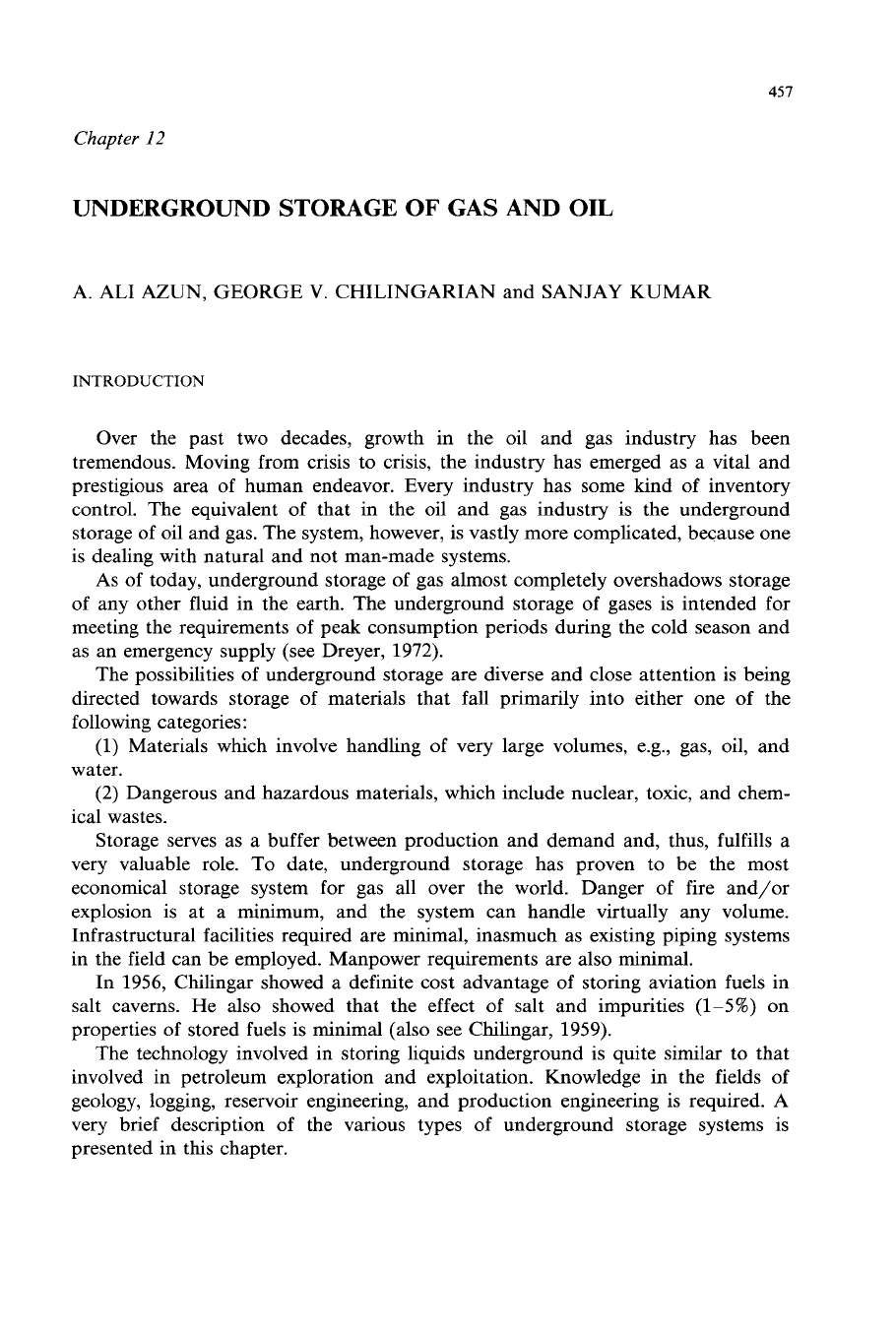
457
Chapter
12
UNDERGROUND STORAGE
OF
GAS
AND
OIL
A. ALI AZUN. GEORGE
V.
CHILINGARIAN and SANJAY KUMAR
INTRODUCTION
Over the past two decades, growth in the oil and gas industry has been
tremendous. Moving from crisis to crisis, the industry has emerged as a vital and
prestigious area of human endeavor. Every industry has some kind of inventory
control. The equivalent of that in the oil and gas industry is the underground
storage of oil and gas. The system, however, is vastly more complicated, because one
is dealing with natural and not man-made systems.
As of today, underground storage of gas almost completely overshadows storage
of any other fluid in the earth. The underground storage of gases is intended for
meeting the requirements of peak consumption periods during the cold season and
as an emergency supply (see Dreyer, 1972).
The possibilities of underground storage are diverse and close attention is being
directed towards storage of materials that fall primarily into either one
of
the
following categories:
(1) Materials which involve handling of very large volumes, e.g., gas, oil, and
water.
(2)
Dangerous and hazardous materials, which include nuclear, toxic, and chem-
ical wastes.
Storage serves as a buffer between production and demand and, thus, fulfills a
very valuable role.
To
date, underground storage has proven to be the most
economical storage system for gas all over the world. Danger of fire and/or
explosion is at a minimum, and the system can handle virtually any volume.
Infrastructural facilities required are minimal, inasmuch as existing piping systems
in the field can be employed. Manpower requirements are also minimal.
In 1956, Chilingar showed a definite cost advantage of storing aviation fuels in
salt caverns. He also showed that the effect of salt and impurities (1-5%) on
properties of stored fuels is minimal (also see Chilingar, 1959).
The technology involved in storing liquids underground is quite similar to that
involved in petroleum exploration and exploitation. Knowledge in the fields of
geology, logging, reservoir engineering, and production engineering is required. A
very brief description of the various types of underground storage systems is
presented in this chapter.

458
STORAGE OF GAS IN DEPLETED GAS AND
OIL
FIELDS
In
the earlier days, a nearly depleted gas field was routinely used for storing
natural gas by allowing it to flow into a gas-bearing formation in summer
so
that
gas would be available when needed in the winter (Katz and Coats, 1968). This was
indeed a minute operation when compared with the present full repressurization of
gas fields each summer and a withdrawal of 50-70% of gas during the winter.
Essential data for the storage operation, i.e., pressure behavior, capacity, achievable
withdrawal rates, etc., are known from the production history of the reservoirs. Only
slight volumes of cushion gas are necessary for the first fill and, usually, the
reservoir still contains sufficient quantities of gas depending on the degree
of
depletion. Depending on the relative permeabilities, the utilizable volumes
of
working gas constitute about
30-50%
of the total gas (gas remaining after depletion
plus that injected into the formation) (Lindemann and Carlson, 1981).
In 1968, Katz and Coats stated that the problems
of
converting depleted gas
fields to gas storage begin with the mechanical refurbishing
of
wells and field lines
to withstand the pressures over a long period of time. The operating pressure
required for storage may be above that existing during gas production, because the
flow rates required to meet peak loads and empty the storage field in the winter are
much higher than those used in normal production practice. Generally, additional
wells may be required for this purpose.
If new fields are discovered in an area where gas storage is possible, they might
be developed with appropriate field gathering lines and well structures suited for
contemplated pressure levels and flow rates for storage operations.
Some oil fields also can be used for gas storage. Many complications arise in this
case, however, because the quantity
of
oil recovered depends upon operating
methods and the unrecovered oil remains in depleted oil fields. Of utmost impor-
tance is the gravity of the crude oil in the reservoir, because this determines the
amount of oil stripped by the gas under equilibrium conditions. A light-hydro-
carbon recovery plant may be required to strip the gas from the storage reservoir of
the propane and heavier constituents absorbed from the oil in the reservoir.
STORAGE IN AQUIFERS
Aquifers are porous formations, the pore space of which is filled with water.
Thus, the water has to be driven away from the gas injection well as the pressure is
increased. As pointed out by Katz and Coats (1968), the development of aquifers for
underground storage includes locating of the underground structure. The quality of
the caprock is determined first by examining and testing the cores. The plasticity of
the rock is of utmost importance, because it determines the degree of fracturing. The
next step is the testing of caprock by pumping water to determine whether a
pressure differential across the caprock causes water movement through it or not.
Upon locating the structure and after all signs point to an impermeable caprock,
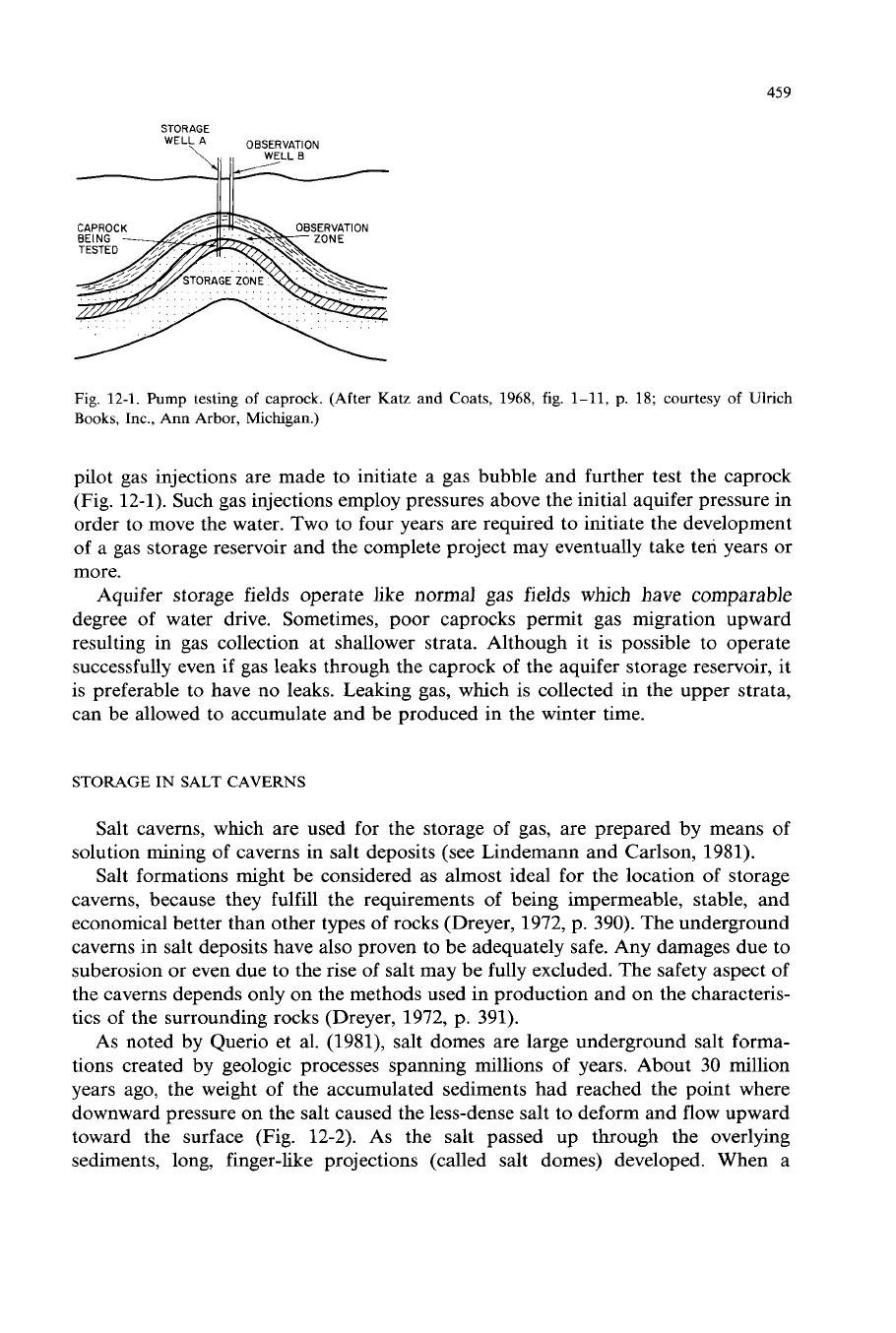
459
STORAGE
Fig.
12-1.
Pump testing
of
caprock. (After Katz and Coats,
1968,
fig.
1-11,
p.
18;
courtesy
of
Ulrich
Books, Inc., Ann Arbor, Michigan.)
pilot gas injections are made to initiate a gas bubble and further test the caprock
(Fig. 12-1). Such gas injections employ pressures above the initial aquifer pressure in
order to move the water. Two to four years are required to initiate the development
of
a gas storage reservoir and the complete project may eventually take ten years or
more.
Aquifer storage fields operate like normal gas fields which have comparable
degree of water drive. Sometimes, poor caprocks permit gas migration upward
resulting in gas collection at shallower strata. Although it is possible to operate
successfully even if gas leaks through the caprock of the aquifer storage reservoir, it
is preferable to have no leaks. Lealung gas, which is collected in the upper strata,
can be allowed to accumulate and be produced in the winter time.
STORAGE
IN SALT CAVERNS
Salt caverns, which are used for the storage of gas, are prepared by means of
solution mining of caverns in salt deposits (see Lindemann and Carlson, 1981).
Salt formations might be considered as almost ideal for the location of storage
caverns, because they fulfill the requirements of being impermeable, stable, and
economical better than other types of rocks (Dreyer, 1972, p. 390). The underground
caverns in salt deposits have also proven
to
be adequately safe. Any damages due to
suberosion or even due to the rise of salt may be fully excluded. The safety aspect of
the caverns depends only on the methods used in production and on the characteris-
tics of the surrounding rocks (Dreyer, 1972, p. 391).
As noted by Querio et al. (1981),
salt
domes are large underground salt forma-
tions created by geologic processes spanning millions of years. About 30 million
years ago, the weight of the accumulated sediments had reached the point where
downward pressure on the salt caused the less-dense salt to deform and flow upward
toward the surface (Fig. 12-2). As the salt passed up through the overlying
sediments, long, finger-like projections (called salt domes) developed. When a
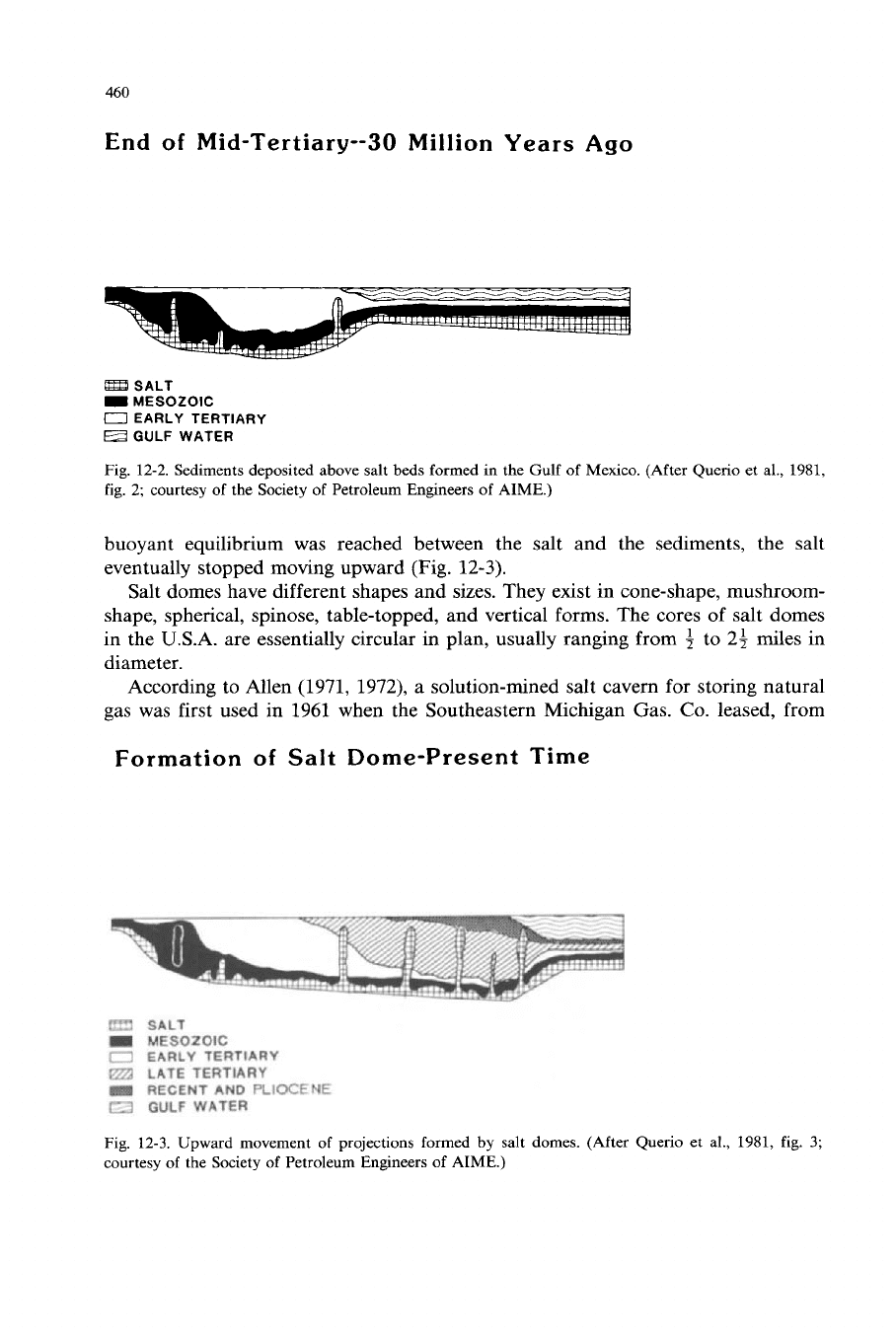
460
End
of
Mid-Tertiary-30 Million Years
Ago
EB
SALT
MESOZOIC
0
EARLY TERTIARY
!3
GULF
WATER
Fig. 12-2. Sediments deposited above salt beds formed
in
the Gulf
of
Mexico. (After Querio et
al.,
1981,
fig. 2; courtesy of the Society
of
Petroleum Engineers
of
AIME.)
buoyant equilibrium was reached between the salt and the sediments, the salt
eventually stopped moving upward (Fig. 12-3).
Salt domes have different shapes and sizes. They exist in cone-shape, mushroom-
shape, spherical, spinose, table-topped, and vertical forms. The cores of salt domes
in the
U.S.A.
are essentially circular in plan, usually ranging from to 2: miles in
diameter.
According to Allen (1971, 1972), a solution-mined salt cavern for storing natural
gas was first used in 1961 when the Southeastern Michigan Gas.
Co.
leased, from
Formation
of
Salt
Dome-Present Time
Fig. 12-3. Upward movement
of
projections formed by salt domes. (After Querio et
al.,
1981, fig.
3;
courtesy of the Society of Petroleum Engineers
of
AIME.)
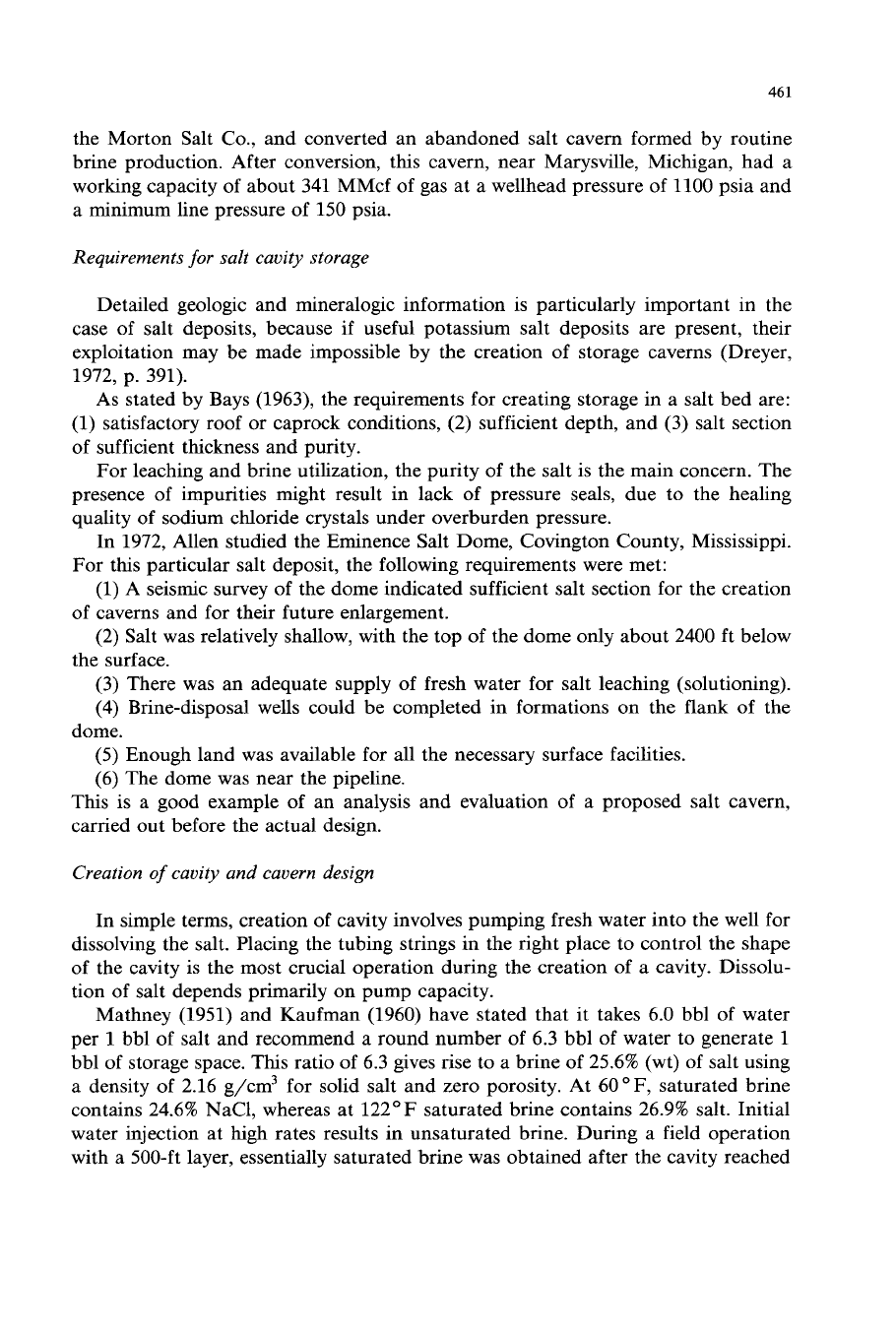
461
the Morton Salt Co., and converted an abandoned salt cavern formed by routine
brine production. After conversion, this cavern, near Marysville, Michigan, had a
working capacity of about 341 MMcf of gas at a wellhead pressure of
1100
psia and
a minimum line pressure of 150 psia.
Requirements for salt cavity storage
Detailed geologic and mineralogic information
is
particularly important in the
case of salt deposits, because
if
useful potassium salt deposits are present, their
exploitation may be made impossible by the creation of storage caverns (Dreyer,
1972, p. 391).
As stated by Bays (1963), the requirements for creating storage in a salt bed are:
(1) satisfactory roof or caprock conditions, (2) sufficient depth, and (3) salt section
of sufficient thickness and purity.
For leaching and brine utilization, the purity of the salt is the main concern. The
presence of impurities might result in lack of pressure seals, due to the healing
quality of sodium chloride crystals under overburden pressure.
In 1972, Allen studied the Eminence Salt Dome, Covington County, Mississippi.
For this particular salt deposit, the following requirements were met:
(1) A seismic survey of the dome indicated sufficient salt section for the creation
of caverns and for their future enlargement.
(2) Salt was relatively shallow, with the top of the dome only about 2400
ft
below
the surface.
(3) There was an adequate supply of fresh water for salt leaching (solutioning).
(4) Brine-disposal wells could be completed in formations on the flank of the
(5)
Enough land was available for all the necessary surface facilities.
(6) The dome was near the pipeline.
dome.
This is a good example of an analysis and evaluation of a proposed salt cavern,
carried out before the actual design.
Creation
of
cavity and cavern design
In simple terms, creation of cavity involves pumping fresh water into the well for
dissolving the salt. Placing the tubing strings in the right place to control the shape
of the cavity is the most crucial operation during the creation of a cavity. Dissolu-
tion of salt depends primarily on pump capacity.
Mathney (1951) and Kaufman (1960) have stated that it takes 6.0 bbl of water
per
1
bbl of salt and recommend a round number of 6.3 bbl of water to generate
1
bbl of storage space. This ratio of 6.3 gives rise to a brine of 25.6% (wt) of salt using
a density of 2.16 g/cm3 for solid salt and zero porosity. At 60 OF, saturated brine
contains 24.6% NaC1, whereas at 122"
F
saturated brine contains 26.9% salt. Initial
water injection at high rates results in unsaturated brine. During a field operation
with a 500-ft layer, essentially saturated brine was obtained after the cavity reached
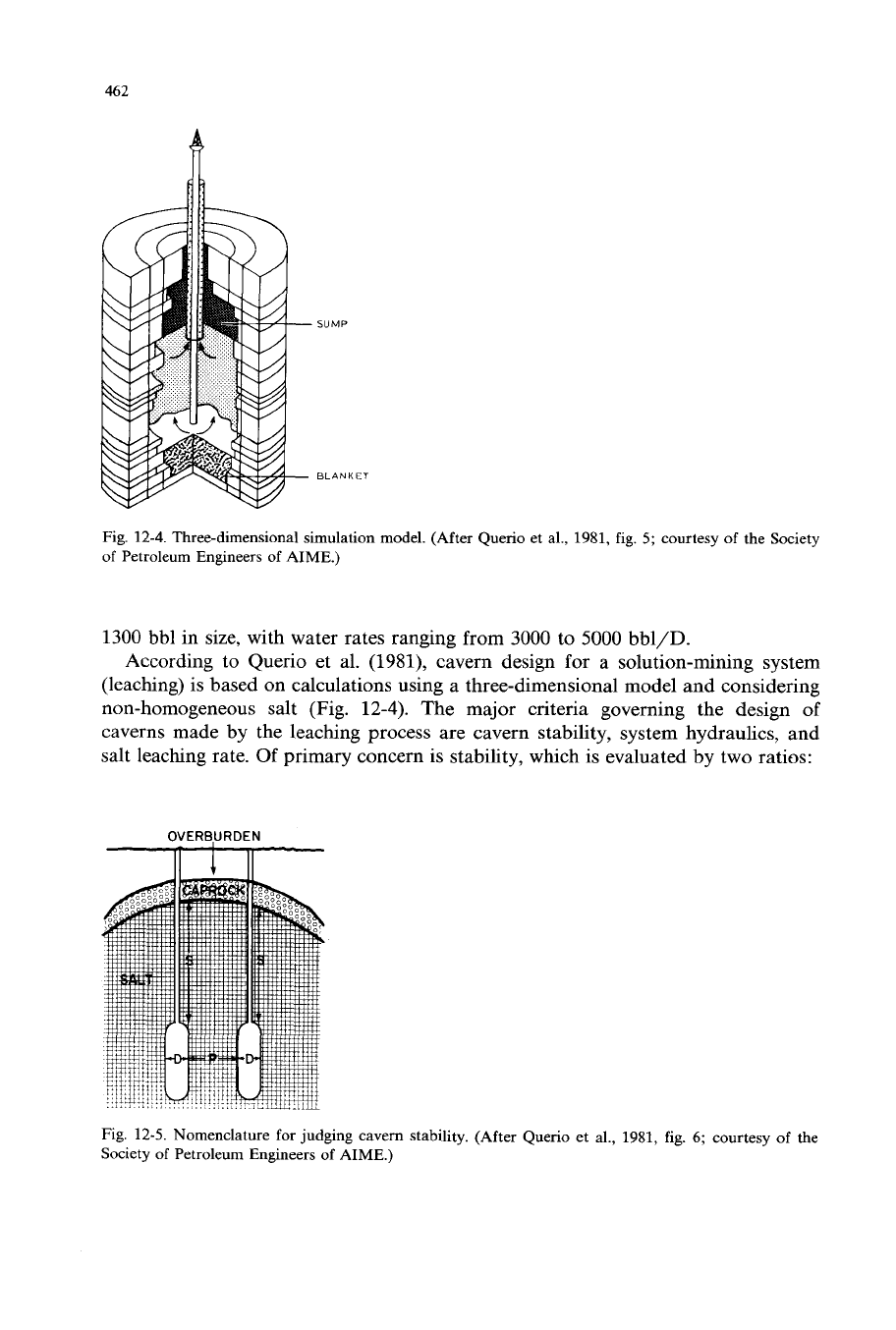
462
A
SUMP
BLANKET
Fig. 12-4. Three-dimensional simulation model. (After Querio et al., 1981,
fig.
5;
courtesy
of
the Society
of Petroleum Engineers of AIME.)
1300 bbl in size, with water rates ranging from 3000 to 5000 bbl/D.
According to Querio et al. (1981), cavern design for a solution-mining system
(leaching) is based on calculations using a three-dimensional model and considering
non-homogeneous salt (Fig. 12-4). The major criteria governing the design of
caverns made by the leaching process are cavern stability, system hydraulics, and
salt leaching rate. Of primary concern
is
stability, which is evaluated by two ratios:
0VERB.U
R
DE
N
Fig. 12-5. Nomenclature for judging cavern stability. (After Querio et al.,
1981,
fig.
6;
courtesy
of
the
Society of Petroleum Engineers of AIME.)
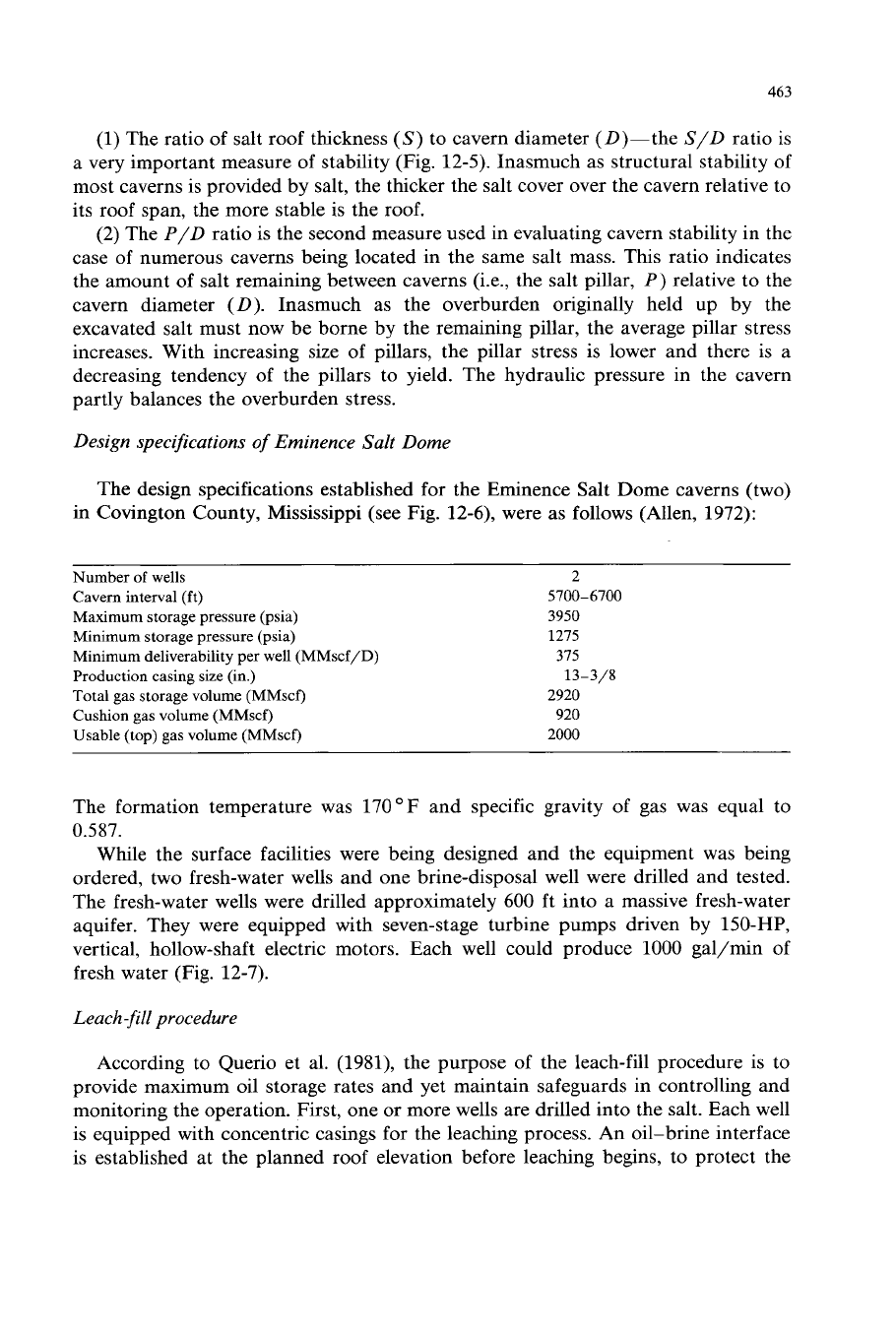
463
(1) The ratio of salt roof thckness
(S)
to cavern diameter (D)-the
S/D
ratio
is
a very important measure of stability (Fig. 12-5). Inasmuch as structural stability of
most caverns is provided by salt, the thicker the salt cover over the cavern relative to
its roof span, the more stable
is
the roof.
(2) The
P/D
ratio is the second measure used in evaluating cavern stability in the
case of numerous caverns being located in the same salt mass. This ratio indicates
the amount of salt remaining between caverns (i.e., the salt pillar,
P)
relative to the
cavern diameter
(D).
Inasmuch as the overburden originally held up by the
excavated salt must now be borne by the remaining pillar, the average pillar stress
increases. With increasing size of pillars, the pillar stress
is
lower and there is a
decreasing tendency of the pillars to yield. The hydraulic pressure in the cavern
partly balances the overburden stress.
Design specifications
of
Eminence Salt Dome
The design specifications established for the Eminence Salt Dome caverns (two)
in Covington County, Mississippi (see Fig. 12-6), were as follows (Allen, 1972):
Number
of
wells
Cavern interval
(ft)
Maximum storage pressure (psia)
Minimum storage pressure (psia)
Minimum deliverability per well (MMscf/D)
Production casing size (in.)
Total gas storage volume (MMscf)
Cushion gas volume (MMscf)
Usable (top) gas volume (MMscf)
2
5700-6700
3950
1275
375
2920
920
2000
13-3/8
The formation temperature was 170°F and specific gravity of gas was equal to
0.587.
While the surface facilities were being designed and the equipment was being
ordered, two fresh-water wells and one brine-disposal well were drilled and tested.
The fresh-water wells were drilled approximately
600
ft into a massive fresh-water
aquifer. They were equipped with seven-stage turbine pumps driven by 150-HP,
vertical, hollow-shaft electric motors. Each well could produce 1000 gal/min of
fresh water (Fig. 12-7).
Leach-fill procedure
According to Querio et al. (1981), the purpose of the leach-fill procedure is to
provide maximum oil storage rates and yet maintain safeguards in controlling and
monitoring the operation. First, one or more wells are drilled into the salt. Each well
is equipped with concentric casings for the leaching process. An oil-brine interface
is established at the planned roof elevation before leaching begins, to protect the
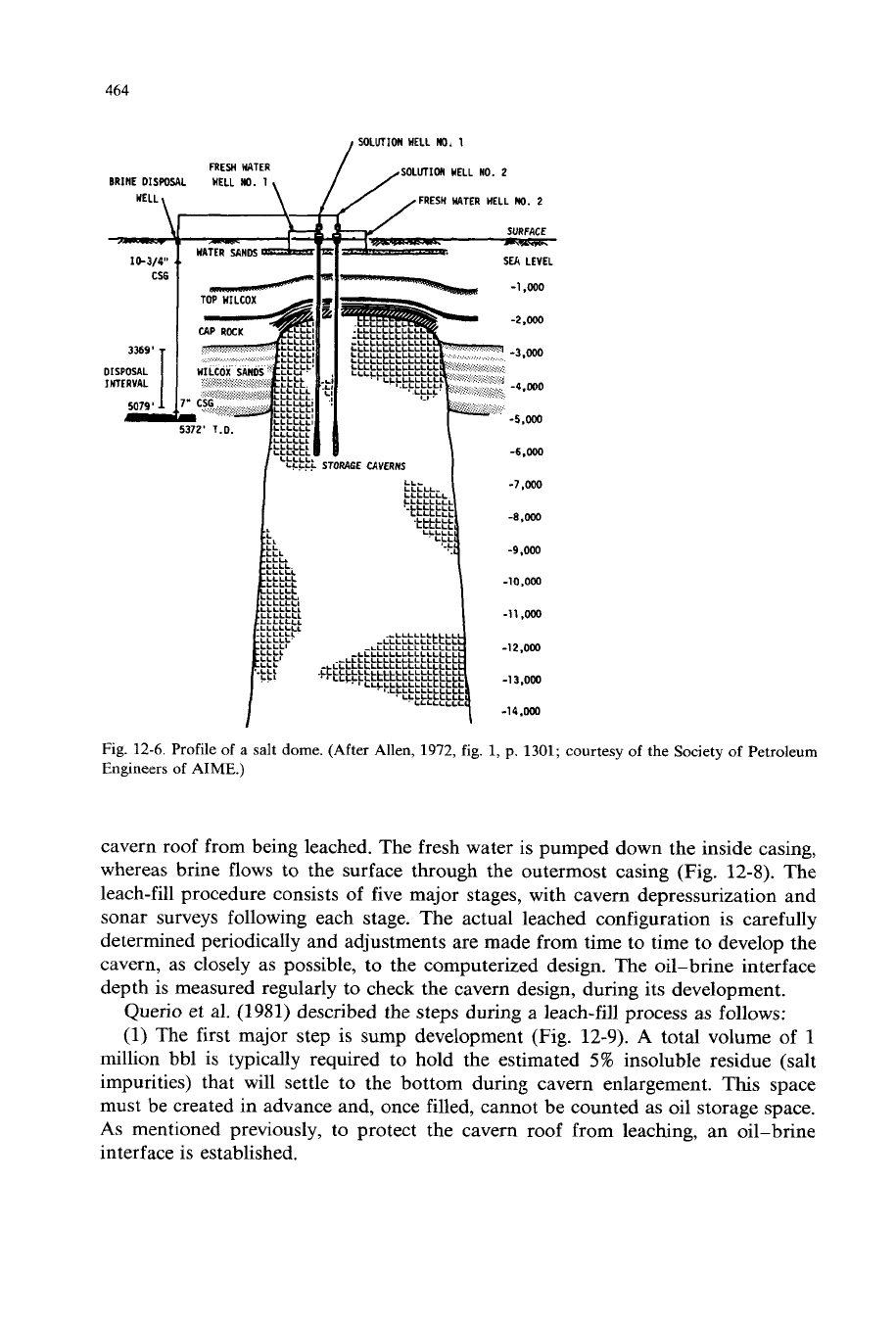
464
SOLUTION WELL
D.
1
SOLLITION YELL
NO.
2
FRESH WATER WELL
D.
2
SEh
LEVEL
/
::L
:::::
LLLLL
LLLLLLi
LLLLLL,
LLLLLLL
&LLLLL,
-LLLLL,
LLLLL
LLLLl
LLLL
:::::::
:::'
.-LLL
-1.000
-2.000
-3.000
-0.wo
-5.000
-6,OW
-7.000
-8.000
-9,000
-1o.oM)
-11
.Ooo
-12,000
-13.000
-14.000
Fig.
12-6. Profile
of
a
salt dome. (After Allen, 1972,
fig.
1,
p.
1301; courtesy
of
the Society
of
Petroleum
Engineers
of
AIME.)
cavern roof from being leached. The fresh water is pumped down the inside casing,
whereas brine flows to the surface through the outermost casing (Fig.
12-8).
The
leach-fill procedure consists of five major stages, with cavern depressurization and
sonar surveys following each stage. The actual leached configuration is carefully
determined periodically and adjustments are made from time to time to develop the
cavern, as closely as possible, to the computerized design. The oil-brine interface
depth is measured regularly to check the cavern design, during its development.
Querio et al.
(1981)
described the steps during a leach-fill process as follows:
(1)
The first major step is sump development (Fig.
12-9).
A
total volume of
1
million bbl
is
typically required to hold the estimated
5%
insoluble residue (salt
impurities) that will settle to the bottom during cavern enlargement. This space
must be created in advance and, once filled, cannot be counted as oil storage space.
As
mentioned previously, to protect the cavern roof from leaching, an oil-brine
interface is established.
